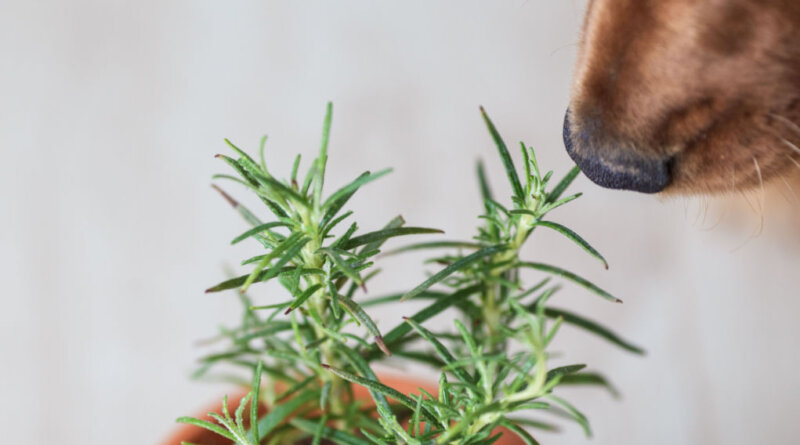4 Herbs Toxic to Dogs – Top Dog Tips
According to a report, marijuana is the most commonly used illicit drug in the United States.
Did you know that besides its health side effects for humans, it’s also a toxic herb for our adorable furry friends?
Even secondhand smoke through inhalation may trigger reactions such as gastrointestinal issues, cardiovascular dysfunction, neurological defects, etc.
The same goes for multiple other substances.
Toxic herbs are everywhere, ranging from the garlic and onions in your kitchen to sago palms as houseplants or even rhubarb leaves growing in a park outdoors.
As responsible parents, we must ensure our dogs are free from harm.
In this blog post, we’ll address common toxic herbs for dogs.
We’ll understand what makes them hazardous, their harmful effects, symptoms, and treatment if ingested.
We’ll also provide a brief guide on adopting preventive measures to ensure your pet’s safety.
So, without further ado, let’s get started!
Herbs That Are Toxic to Dogs
Our canine companions thrive best when they’re consuming a diet that is suitable for them.
Apart from ensuring they eat healthily, we also need to avoid edibles that are harmful to them.
These include toxic herbs that may invoke side effects or lead to undesirable consequences for our beloved furry friends.
Here, we have compiled a list of toxic herbs for dogs that must be avoided at all costs for the health and wellness of our four-legged buddies.
Garlic and Onion
Garlic and onion are popular ingredients for many cuisines around the world.
Humans like them for their unique flavor and aroma. Still, this herb may trigger unintended adverse effects in your pet.
Garlic and onions contain compounds called organosulfoxides.
These turn into a complex mixture of sulfur compounds often linked to damage to a dog’s red blood cells and lead to body anemia for our furry friends.
According to a Frontiers in Veterinary Science study, “Cooking, drying, and processing do not eliminate the toxic effect” associated with them.
The same research suggests that ingesting 15-30 g/kg of onions by dogs is sufficient to cause changes in the blood, which requires immediate clinical help to recover.
Harmful Effects on Dogs
The extent of the harm may depend on the dog’s sensitivity toward these substances. This may depend on a combination of heredity or your pet’s breed.
For example, breeds such as Akita, Shiba, and Jindo are considered more sensitive toward onion and garlic consumption and are more likely to exhibit ill health than others.
Your pet’s red blood cells may begin to damage as they eat these herbs.
In addition, they may decrease your dog’s hemoglobin rate, further fueling changes in blood chemistry.
In some cases, damage to the liver is observed, whereas, in others, gastrointestinal problems are more prominent.
Neurological symptoms, such as tremors and seizures, are also present in rare cases.
Each dog is a unique mix of heredity and upbringing and may react differently, depending on their overall health before consumption.
Symptoms of Garlic and Onion Poisoning in Dogs
The symptoms of garlic and onion poisoning in dogs may vary, depending on your pet’s health and size and the duration of the consumption (that is, how long they ate it for).
Studies suggest that these may begin to appear “1 day or several days after consumption depending on the amounts ingested”. Frequently recurring signs include:
- Vomiting and diarrhea
- Abdominal pain
- Loss of appetite
- depression
- Lethargy and weakness
- Pale gums
- Increased heart rate
- Rapid breathing
- Collapse
It is important to remember that all dogs are unique and may not respond in similar ways.
A quick analysis of your dog’s prior history may indicate how they commonly react when sick.
Treatment for Garlic and Onion Poisoning
Suppose your dog seems unwell, and you suspect the ingestion of onions and garlic to be the underlying cause.
In that case, it’s essential to contact a veterinarian immediately.
The treatment may vary depending on the severity of the poisoning and your pet’s symptoms.
Generally, it may entail one or two of the following:
- Induce vomiting to get the toxic herb out of the system.
- Activated charcoal to absorb the remaining toxins from the system
- Hospitalization and supportive care, including intravenous fluids, blood transfusions, and oxygen therapy, if the condition seems critical
- Surgery to remove remaining onion from your dog’s system in the severest of cases
Marijuana
While marijuana may be legal for medical or recreational uses in some places, that does not make it any less dangerous for our furry friends.
Harmful Effects on Dogs
The active ingredient in marijuana, THC (tetrahydrocannabinol), is responsible for the drug’s psychoactive effects and may be harmful to dogs, depending on the amount ingested.
It is important to note that consuming this substance through plants or edibles is not the only thing that would invoke negative side effects.
Even inhaling secondhand smoke through marihuana products intended for human consumption may lead to multiple adverse reactions in your pet’s body.
These may range from:
- Toxicity (such as vomiting, diarrhea, loss of coordination, respiratory depression, etc.)
- Neurological effects (such as depression, lethargy, confusion, loss of consciousness, etc.)
- Cardiovascular dysfunction (such as increased heart rate and low blood pressure)
- Urinary incontinence (accidental loss of urine)
- Gastrointestinal distress (vomiting and diarrhea, etc.)
Symptoms of Marijuana Poisoning in Dogs
The symptoms may vary depending on facts such as the breed of the dog, its size and weight, and the amount ingested.
Common symptoms of marijuana poisoning include:
Lethargy or depression
Your pet may appear less active than usual or exhibit an apparent disinterest in activities he used to enjoy before, such as his favorite games.
Incoordination
Drugs affect coordination and balance, so your formerly active and strong pet may begin to stumble, sway from side to side, etc.
Dilated pupils
THC may make your pet’s pupils larger than before consumption.
Vomiting
Your dog’s system may act up to flush the toxins out of the scenario through vomiting.
Dribbling urine
Your pet may lose control of its bladder, leading to involuntary loss of urine at random places.
Treatment for Marijuana Poisoning
Treatment may vary depending on the prominent reactions your dog seems to be suffering from.
These may range from:
- Decontamination through induced vomiting or stomach pumping to flush the remaining marijuana out of your pet’s body.
- Intravenous fluids to prevent dehydration that is usually associated with diarrhea and vomiting.
- Monitoring to observe changes in heart rate, blood pressure, and respiratory rate to ensure things are going well and to provide supportive care if needed.
- Medication to control symptoms such as nausea or providing anticonvulsants in case of seizures.
Rhubarb Leaves
While the stalks of rhubarb leaves were commonly used in cooking, baking, and medicinal purposes, the leaves are considered inedible.
They may be toxic to humans and animals, including dogs.
Harmful Effects on Dogs
Rhubarb leaves contain high levels of oxalic acid, a natural compound associated with the formation of calcium oxalate crystals in the bloodstream when ingested.
If left untreated, these crystals can accumulate in the kidneys and urinary tract, leading to kidney damage or failure.
It is also known to cause irritation and inflammation of the digestive system, leading to gastrointestinal problems such as vomiting, diarrhea, and abdominal pain.
It may also contain other side effects, such as appetite loss, weakness, and lethargy.
Although relatively rare, seizures are another adverse effect of consuming rhubarb leaves for dogs.
Symptoms of Rhubarb Leaves Poisoning in Dogs
Even if multiple dogs are suffering from the same form of poisoning, their symptoms may vary depending on their breed, heredity, and the extent of exposure to the herb.
Rhubarb poisoning may manifest as:
- Stomach contents may be emptied out in the form of vomiting
- Bowel movements may be more loose or watery than usual
- Pain or discomfort in the belly area
- Excessive saliva production (to get rid of the toxic substance)
- Lack of desire to eat
- Reduced strength or energy to do everyday tasks
- Increased drowsiness or sleep
- Involuntary and uncontrollable shaking, trembling, or muscle contractions
- Loss of consciousness in the severest of cases
Treatment for Rhubarb Leaves Poisoning
If your dog is showing symptoms of rhubarb leaf poisoning, then it might be time to consult a veterinarian.
Treatment will often depend on the severity of the poisoning and the kind of help required to restore the dog’s body back to optimal levels of functioning.
Generally, induced vomiting and activated charcoal are common ways of minimizing the remaining effects of rhubarb leaf poisoning by eliminating it from your pet’s body.
Since vomiting and diarrhea may leave your pet dehydrated, IV fluids may also be given to ensure sufficient intake of liquids.
Then, medication may be provided to combat the various symptoms, or supportive care (such as oxygen therapy or hospitalization) may be recommended as per the condition.
Sago Palm
The Sago Palm is a common herb and houseplant kept for its striking tropical appearance and low maintenance.
If you have pets such as dogs, you must be mindful of their threat to your dog’s health.
All parts of these plants are poisonous, but the seeds are regarded as the most toxic.
Harmful Effects on Dogs
Sago Palms contain cycasin and other toxins that may contribute to adverse reactions in your dog when ingested.
APCC records show sago palm was one of the most frequently reported poisonous plants causing serious systematic effects amongst dogs.
This is because cycasin, a type of glycoside, has been associated with severe liver damage and even liver failure among dogs.
It is also linked with gastrointestinal issues such as vomiting, diarrhea, and bloody stools.
Depending on the amount ingested, these may take a few hours or days to appear.
Symptoms of Sago Palm Poisoning in Dogs
Symptoms of sago palms may be similar to other types of poisoning.
They may vary from vomiting, diarrhea, loss of appetite and subsequent lethargy and weakness, abdominal pain, etc.
Severe cases may include liver failure or even death if left untreated for long periods.
This is why monitoring dogs is essential when you have a toxic herb around your home.
If you suspect your dog of ingesting a hazardous substance such as sago palm, rush to the veterinarian immediately for guidance and treatment.
Treatment for Sago Palm Poisoning
Once you arrive at the vet, he may prescribe a treatment plan depending on the amount ingested and the severity of the case.
Generally, an induced vomiting procedure or activated charcoal is used to suck the sago palm out of your pet’s body to control the side effects your furry friend is experiencing.
Poisoning through ingesting toxic herbs entails vomiting and diarrhea, possibly dehydrating your dog.
For that, intravenous (IV) fluids may be administered to ensure your pet does not feel sluggish, tired, or weaker than they need to.
Then, medication may be given to control the remaining symptoms your dog seems to be facing.
In severe cases, your dog may also be hospitalized to monitor any worsening or improvement in health until your pet fully recovers.
Precautions To Take on Herbs Toxic to Dogs
Precaution is better than cure.
We’ve heard that countless times and the statement still resonates. The truth is treatment, although significant, is a time-consuming and expensive process.
The better approach is to eliminate the problem from the root and adopt measures that minimize the chances of your beloved canine companion approaching herbs that may be toxic for them. This includes:
Identification of Toxic Herbs
Learning about which herbs are healthy or toxic for dogs is necessary to ensure the safety and security of your pet.
Scan the various plants lying around your home or even outdoors.
List their names and begin researching whether they’re harmless or dangerous. This will make monitoring your canine companion easier for you.
If you cannot remove them completely (for example, if they’re in a park), you may teach them a command that conditions them to instantly move away from the toxic herb when uttered.
Safe Storage and Disposal of Toxic Herbs
Dogs are curious creatures and may accidentally stumble upon and ingest a herb that is toxic to them.
To prevent such unintentional damages, try storing them in a place that is inaccessible to them. This may include an elevated or locked cabinet, etc.
If you intend to dispose of the herb you have found, do not just throw it in the trash (where your dog may still find it and sniff around).
It’s better to contact your waste management facility and ask them for any regulations they may have on the procedure.
Steps To Take if Dog Ingests Toxic Herbs
If you suspect your dog has ingested an herb that may harm them, staying calm is important.
While it may be difficult, doing so will allow you to take the necessary steps without feeling paralyzed with anxiety or fear.
Remember: any form of poisoning is treatable in most cases.
The next step is to contact a veterinarian immediately.
While induced vomiting may seem like a plausible at-home cure, it is not recommended to do so as it requires a professional to administer it properly.
The vet will perform a checkup and then prescribe a treatment plan.
It may take as long as a few hours or several days, depending on the amount ingested, the severity of the case, and the dog’s overall health.
Herbs Toxic to Dogs: Conclusion
Most pets recover and may return to normal after the treatment.
The important lesson is to learn from our human experience and take better care of our loveable furry friends as needed.
While we may not be the best at times, we must evolve as our learning grows to be the best pet parents that our dogs require us to be.
RELATED READS:









